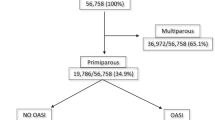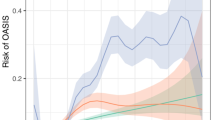Abstract
Objective
To evaluate obstetric sphincter lacerations after a kneeling or sitting position at second stage of labor in a multivariate risk analysis model.
Materials and methods
Two hundred and seventy-one primiparous women with normal pregnancies and spontaneous labor were randomized, 138 to a kneeling position and 133 to a sitting position. Medical data were retrieved from delivery charts and partograms. Risk factors were tested in a multivariate logistic regression model in a stepwise manner.
Results
The trial was completed by 106 subjects in the kneeling group and 112 subjects in the sitting group. There were no significant differences with regard to duration of second stage of labor or pre-trial maternal characteristics between the two groups. Obstetrical sphincter tears did not differ significantly between the two groups but an intact perineum was more common in the kneeling group (p<0.03) and episiotomy (mediolateral) was more common in the sitting group (p<0.05). Three grade IV sphincter lacerations occurred in the sitting group compared to none in the kneeling group (NS). Multivariate risk analysis indicated that prolonged duration of second stage of labor and episiotomy were associated with an increased risk of third- or fourth-degree sphincter tears (p<0.01 and p<0.05, respectively). Delivery posture, maternal age, fetal weight, use of oxytocin, and use of epidural analgesia did not increase the risk of obstetrical anal sphincter lacerations in the two upright postures.
Conclusion
Obstetrical anal sphincter lacerations did not differ significantly between a kneeling or sitting upright delivery posture. Episiotomy was more common after a sitting delivery posture, which may be associated with an increased risk of anal sphincter lacerations. Upright delivery postures may be encouraged in healthy women with normal, full-term pregnancy.

Similar content being viewed by others

References
Zetterstrom J, Lopez A, Anzen B, Norman M, Holmstrom B, Mellgren A (1999a) Anal sphincter tears at vaginal delivery: risk factors and clinical outcome of primary repair. Obstet Gynecol 94:21–28
Gupta JK, Nikodem VC (2002) Position for women during second stage of labour (Cochrane review). In: The Cochrane library. Update Software, Oxford
Stewart P, Hillan E, Calder A (1983) A randomised trial to evaluate the use of a birth chair for delivery. Lancet 1(8337):1296–1298
Gardosi J, Hutson N, B-Lynch C (1989) Randomised, controlled trial of squatting in the second stage of labour. Lancet 2:74–77
Waldenstrom U, Gottvall K (1991) A randomized trial of birthing stool or conventional semirecumbent position for second-stage labor. Birth 18:5–10
de Jong PR, Johanson RB, Baxen P, Adrians VD, van der Westhuisen S, Jones PW (1997) Randomised trial comparing the upright and supine positions for the second stage of labour. Br J Obstet Gynaecol 104:567–571
Borrel V, Fenstrom I (1957) The movements of the sacro-iliac joints and their importance to changes in pelvic dimensions during parturition. Acta Obstet Gynecol Scand 36(1):42–57
Mendez-Bauer C, Arroyo J, Garcia Ramos C et al (1975) Effects of standing position on spontaneous uterine contractility and other aspects of labor. J Perinat Med 3(2):89–100
Gareberg B, Magnusson B, Sultan B, Wennerholm UB, Wennergren M, Hagberg H (1994) Birth in standing position: a high frequency of third degree tears. Acta Obstet Gynecol Scand 73:630–633
Ragnar I, Altman D, Tydén T, Olsson S-E (2006) Maternal experience and duration of second stage of labour comparing two upright delivery positions— a randomised controlled trial. Br J Obstet Gynaecol 113:165–170
WHO (1992) International classification of diseases and health related problems, tenth revision. ICD10 Switzerland
Russel J (1982) The rationale of primitive delivery positions. Br J Obstet Gynaecol 89:712–715
Sultan AH, Kamm MA, Hudson CN, Thomas JM, Bartram CI (1993) Anal-sphincter disruption during vaginal delivery. N Engl J Med 329:1905–1911
Sultan AH (1997) Anal incontinence after childbirth. Curr Opin Obstet Gynecol 9:320–324
Zetterstrom JP, Lopez A, Anzen B, Dolk A, Norman M, Mellgren A (1999b) Anal incontinence after vaginal delivery: a prospective study in primiparous women. Br J Obstet Gynaecol 106:324–330
Shorten A, Donsante J, Shorten B (2002) Birth position, accoucheur, and perineal outcomes: informing women about choices for vaginal birth. Birth 29:18–27
Haadem K, Dahlstrom JA, Ling L, Ohrlander S (1987) Anal sphincter function after delivery rupture. Obstet Gynecol 70:53–56
Moller Bek K, Laurberg S (1992) Intervention during labor: risk factors associated with complete tear of the anal sphincter. Acta Obstet Gynecol Scand 71:520–524
Fornell EK, Berg G, Hallbook O, Matthiesen LS, Sjodahl R (1996) Clinical consequences of anal sphincter rupture during vaginal delivery. J Am Coll Surg 183:553–558
Angioli R, Gomez-Marin O, Cantuaria G, O’Sullivan MJ (2000) Severe perineal lacerations during vaginal delivery: the University of Miami experience. Am J Obstet Gynecol 182:1083–1085
Samuelsson E, Ladfors L, Lindblom BG, Hagberg H (2002) A prospective observational study on tears during vaginal delivery: occurrences and risk factors. Acta Obstet Gynecol Scand 81:44–49
Rockner G, Fianu-Jonasson A (1999) Changed pattern in the use of episiotomy in Sweden. Br J Obstet Gynaecol 106:95–101
Goldberg J, Holtz D, Hyslop T, Tolosa JE (2002) Has the use of routine episiotomy decreased? Examination of episiotomy rates from 1983 to 2000. Obstet Gynecol 99:395–400
Riskin-Mashiah S, O’Brian Smith E, Wilkins IA (2002) Risk factors for severe perineal tear: can we do better? Am J Perinatol 19:225–234
Williams A (2003) Third-degree perineal tears: risk factors and outcome after primary repair. J Obstet Gynaecol 23:611–614
Christianson LM, Bovbjerg VE, McDavitt EC, Hullfish KL (2003) Risk factors for perineal injury during delivery. Am J Obstet Gynecol 189:255–260
Author information
Authors and Affiliations
Corresponding author
Additional information
Summary Kneeling and sitting upright during delivery does not differ significantly in pelvic floor lacerations or immediate post-partum morbidity.
Rights and permissions
About this article
Cite this article
Altman, D., Ragnar, I., Ekström, Å. et al. Anal sphincter lacerations and upright delivery postures—a risk analysis from a randomized controlled trial. Int Urogynecol J 18, 141–146 (2007). https://doi.org/10.1007/s00192-006-0123-9
Received:
Accepted:
Published:
Issue Date:
DOI: https://doi.org/10.1007/s00192-006-0123-9



